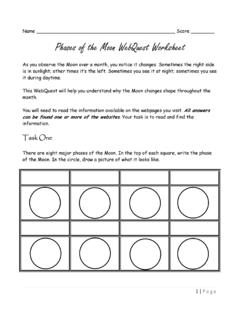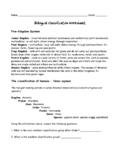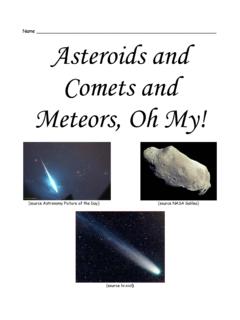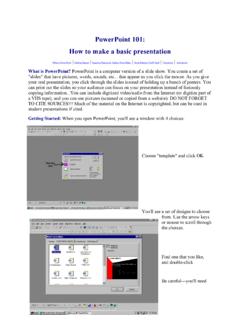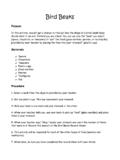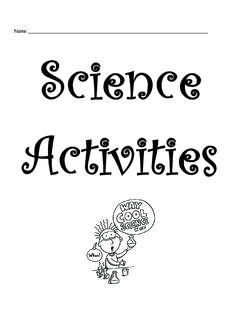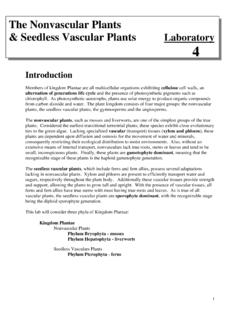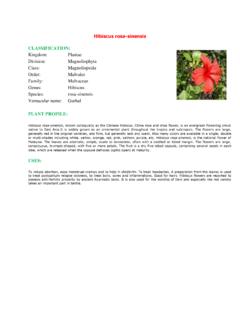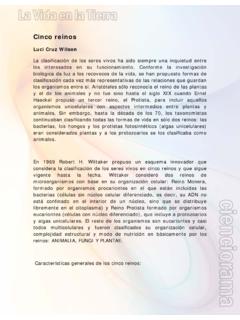Transcription of Name Score - mrscienceut.net
1 name _____ Score _____/61. Classification Test 1. Which of the following is an example of an ORGANISM? a. Lettuce leaf c. Steel b. Maple tree d. Wood 2. Which group contains examples of materials that were NOT part of a living thing? a. water, sugar, salt, pepper c. milk, rubber, iron, copper b. onion, water, celery, milk d. steel, glass, ink, cement 3. Which group contains ONLY living or once-living matter? a. hair, glass, steel, ink c. paper, sand, salt, wood b. hair, wood, blood, leaf d. steel, salt, rubber, rock 4. Which would be the best example of organisms that have been classified by a similarity in structure? a. dog, fox, coyote d. antelope, deer, rabbit b. bear, rabbit, coyote e. horse, antelope, bear c. cat, horse, dog 5. In the scientific name of a dog, Canis familiaris, the name Canis is the name of the dog's _____. a. family c. kingdom b. genus d. species 6. Which of the following characteristics would be appropriately used in developing a classification key for fish?
2 A. The shape of the fish's head. c. What lure or bait caught the fish. b. The size of the fish. d. How long the fish lived. 7. The language used for scientific names is: a. Latin c. English b. Greek d. Spanish 8. In which kingdom would a multicellular green food-producer be placed? a. Animalia d. Plantae b. Fungi e. Protista c. Monera 9. Which of these organisms would seem to be most closely related? 1. Canis familiaris 2. Mephitis mephitis 3. Canis lupus 4. Panthera pardus. a. 1 and 2 c. 2 and 3. b. 1 and 3 d. 2 and 4. 10. Which of the following is true when an organism has the same scientific name as another organism? a. This does not happen in scientific classification. b. They share one or two common traits. c. They are the same species. d. Someone made a mistake naming them. 11. Which of the following characteristics would be appropriately used in developing a classification key for birds?
3 A. Where the bird was seen. c. What food the bird eats b. How plentiful that bird is in d. Color markings on the bird's your neighborhood head. 12. Binomial nomenclature. a. A way used to classify organisms. c. Unique name given an organism. b. Two names. d. ALL of the above. 13. A MAJOR DIFFERENCE between animals and plants is that a. Plants cannot move on their own. b. Plants can make their own food. c. Plants don't need air. d. Plants do not respond to stimuli. 14. In the past scientists used to classify living things into either the plant or animal kingdoms. Today it is customary to use a classification system that uses five kingdoms, and many scientists favor six. Which answer below best explains why? a. Modern day scientists are better at thinking and analyzing than scientists from the past. b. Modern day scientists are better at noticing details than scientists from the past.
4 C. Modern day scientists work harder today than they did in the past. d. Modern day scientists have better technology to analyze and classify organisms than in the past. 15. Many sponges look somewhat like plants. Which of the following is a major reason why they are classified as animals? a. They live in water. c. They do not move. b. They have pores. d. They do not make food. 16. _____ was the first person to classify things. a. Aristotle c. Eratosthenes b. Socrates d. Democritus 17. Which answer below best describes the future of our modern classification system for biological organisms? a. It will probably stay the same because scientists have learned all there is to know about classifying organisms. b. It will probably stay the same because scientists don't like to change things. c. It will probably change because scientists like to change things from time to time. d. It will probably change because new technology will provide better information on classifying organisms.
5 18. Many people have the misconception that mushrooms belong to the Plant kingdom. To disprove this misconception you conduct an experiment by growing plants and mushrooms under different amounts of light. You obtain the following data from your experiment. Organism Amount of Hours of light Growth/description water per day per day after 2 weeks Mushroom 100 ml 8 4 inches healthy #1. Mushroom 100 ml 0 4 inches healthy #2. Plant #1 100 ml 8 4 inches healthy Plant #2 100 ml 0 0 inches - dead Based upon these data, which of the following is the best conclusion? a. Mushrooms belong to the Plant kingdom because they can grow in light. b. Mushrooms belong to the Plant kingdom because they need water. c. Mushrooms do NOT belong to the Plant kingdom because they can grow in the dark. d. Mushrooms do NOT belong to the Plant kingdom because they need water. 19. Which of the following are observable properties?
6 A. External structure. c. Living, once living, non-living. c. Patterns. d. ALL of the above. 20. Which of the following is the HIGHEST level of the classification hierarchy? a. Family c. Genus b. Kingdom d. Phylum 21. Who is the Father of Modern Classification? a. Carolus Linnaeus c. Benjamin Banneker b. Gregor Mendel d. Louis Pasteur 22. How many species can have the SAME scientific name ? a. 1 b. 2. c. 3 d. 4. Matching Select the correct definition for the word: 1. _____ Organism A. Smallest of classification grouping. 2. _____ Genus B. Put things into different groups. 3. _____ Diversity C. Many different things; variety of something. 4. _____ Classification D. First part of the scientific name . 5. _____ Species E. Any living thing. True/False Justify (3 points each). Read the statement. If it is true, circle T and go on to the next statement. If it is false, circle F and CORRECT THE SENTENCE SO IT IS TRUE.
7 T F 1. A dichotomous key asks you THREE questions that you have to answer. T F 2. Erithacus johnstoniae and Erithacus rubecula ARE related species. T F 3. Classification systems NEVER change. Short Answer 1. List the levels of the classification hierarchy. (7 points). a. b. c. d. e. f. g. 2. Identify the pictures below using the dichotomous key. (6 points). A B. C D. E F. 1. Has four legs Go to #2. Has two or less legs Go to #3. 2. Has horns or plates Go to #4. Has no horns or plates Diplodocus 3. Has two legs Go to #5. Has no legs Pterosaur 4. Has horns Triceratops Has plates on back Stegosaurus 5. Has large mouth with sharp teeth T-Rex Is smallest in size Velociraptor Complete the Table Dinosaur Species A. B. C. D. E. F. Allen's Law When all else fails, read the directions. Opportunity is missed by most people because it is dressed in overalls and looks like work. -Thomas Edison Below are pictures of organisms.
8 Decide if they belong to the plant or animal kingdom. If it belongs to the plant or animal kingdom, select A. If it does not belong to the plant or animal kingdom, select B. #1 #2 #3. #4 #5 #6. #7 #8 #9. #10 #11. #12. Organism A or B Organism A or B Organism A or B. #1 #5 #9. #2 #6 #10. #3 #7 #11. #4 #8 #12.
